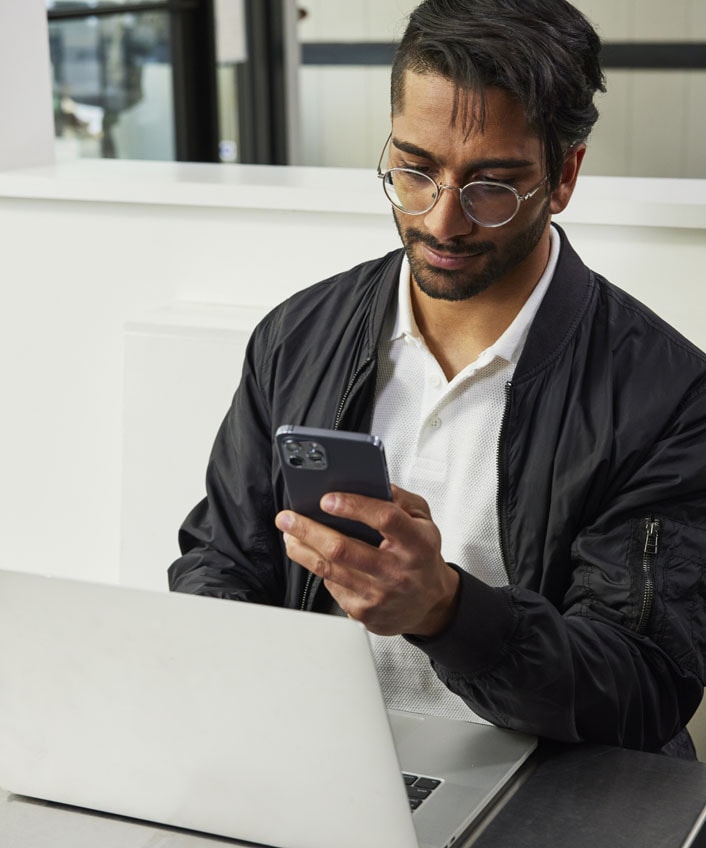Webcam security: Prevent a hacked webcam and stay safer online.
Webcams are useful tools for engagement and connectivity, but hacked webcams are an attacker’s dream. Stay safer online with our guide.


Get your membership of Norton 360 with LifeLock
Norton 360 with LifeLock protects against ever-evolving cyberthreats – helping you protect your personal information with comprehensive protection for your devices, identity and online privacy.
Learn about our plans.
How many times did you have a webcam pointed at you today? The reality is that there’s a camera focused on you every time you pick up your phone, work on a computer, or browse on a tablet.
So it’s no surprise that webcam hacking has become a serious concern in recent years, with all of us potentially at risk of having our privacy invaded by cybercriminals.
When the likes of Mark Zuckerberg and former FBI director James Comey cover their laptop camera with tape, it may be something you should consider.
Why hacked cameras are a major risk for you
Webcam hacking or camfecting describes what happens when hackers take remote control of your camera and disable the indicator light that tells you it’s in use. That means that they could be watching you on your laptop without you even knowing it.
Next to poor password hygiene, a compromised camera can be one of the biggest risks to your online security. Hackers can use your camera to spy on you in your most unguarded moments and use captured images or videos to blackmail you.
The malware used to take control of your camera can even give them access to other sensitive data on your device.
Strangers could also be watching you on sites that livestream footage from unsecured webcams so you don’t necessarily have to have your webcam hacked to be at risk. If you have unsecured devices with cameras or independent webcams around your home, there’s always a chance that prying eyes could be watching you.
What is a Trojan webcam?
If you’ve ever had your work computer remotely accessed by an IT operative, you’ll know how strange it is to see someone operating it from a distance. When hackers use a Remote Administration Tool (RAT) to take control of your computer, they’re less likely to announce their presence.
It’s easier than you think to download this type of Trojan horse malware, which can convert your connected camera into a spying device. You may think you’re downloading a legitimate update but instead are inadvertently clicking on a malicious link. That can be all it takes to get infected.
This type of malware can be easily deployed in an email or attachment but it can also be uploaded on your device with a USB drive if the hacker has access to your physical computer.
Once this RAT malware infects your phone or computer, a hacker can use it to take control of your device and access your webcam remotely. This malware allows them to activate the camera, take pictures, record footage or listen to your conversations.
Unfortunately, this type of Trojan virus can also give the hacker access to your messages, files, browsing history, images or other sensitive information.
Because these cases are so hard to detect, it can sometimes seem like it’s not a major problem. However, some high profile sextortion cases show how hackers can prey on their victims’ fears for financial gain.
One of the most infamous webcam hacking cases involved Miss Teen USA 2013, Cassidy Wolf, who was blackmailed by a former classmate who had hacked into her webcam. The 19-year-old perpetrator had hacked into the computers of at least two dozen women and threatened to release naked pictures of his victims to social media unless a ransom was paid.
Webcam hacking can go entirely undetected for years, with hackers capable of accessing their victims’ devices over long periods of time. In 2018, a man in Ohio was charged with spying on thousands of people through their devices’ cameras over the course of 14 years.
It’s not just hackers that have access to this type of malware, with some forms of Trojan malware available for free on the dark web. When criminals with limited computer skills can source RAT kits like NanoCore RAT at no expense, it’s no surprise that this type of cybercrime is on the rise.
Other types of webcam hacking
Using a RAT may be one of the most common forms of webcam hacking but it’s not the only one. Cybercriminals have also taken advantage of the rising popularity of Internet of Things (IoT) devices and the move to remote working during lockdown saw hackers target video conferencing software.
The proliferation of Internet of Things (Iot) devices has increased their owners’ risk, with everything from doorbells to home security systems now open to webcam hacking. The FBI has previously warned people buying smart TVs to put black tape over the television’s camera to avoid being watched by bad actors.
There have also been numerous cases where internet-connected baby monitors have been hacked by cybercriminals. With the number of incidents soaring, the New York City Department of Consumer Affairs even launched an investigation into the baby monitor industry's security weaknesses in 2016, sending subpoenas to four companies.
Often these devices lack the strong defences of a laptop or computer so they can be easy to hack, especially if owners haven’t activated their password protection.
Apps and software can also be used to carry out webcam hacking, with one of the earliest examples being a Facebook webcam hack that was discovered in 2012. Security experts discovered a bug that allowed cybercriminals to take control of a person’s webcam without their knowledge.
This bug was subsequently fixed but Zoom was recently found to have a similar bug that allowed hackers to take over a Zoom user’s Mac, including the camera and microphone. It wasn’t the only scandal to be associated with the popular video conferencing tool, after Singapore banned teachers from using it to give remote lessons during lockdown. The decision came after hackers were able to access live Zoom calls to post obscene imagery and make lewd comments.
Should you cover your webcam?
The potential danger posed by webcams was highlighted when eagle-eyed internet users spotted that Mark Zuckerberg’s laptop had tape over its camera and microphone in a picture that he posted to Facebook.
The social media magnate isn’t the only high profile person to adopt this defence. James Comey explained why he had started covering his camera with a statement that might make you consider this tactic.
“I put a piece of tape over the camera because I saw somebody smarter than I am had a piece of tape over their camera,” the former FBI director said.
With webcam hacking on the rise, it’s a simple way to secure your camera and ensure that nobody is watching you without your permission.
Working from home has become the norm for many people since lockdown and cybercriminals have been trying to take advantage of our changing habits and circumstances. There was a massive increase in phishing attacks during lockdown, which is one way that hackers can get you to download a RAT.
One in 10 people actually know someone whose webcam was hacked, according to a recent survey.
No operating system is unhackable, so it doesn’t matter what type of computer or phone you have. They can all be compromised by this type of cybercrime if your device becomes infected with malware. Something as simple as a piece of software that hasn’t been updated can act as a convenient back door for a hacker.
Perhaps most surprisingly, it’s not just hackers that you need to worry about. Edward Snowden revealed that British surveillance agency GCHQ, with the aid of the National Security Agency in the United States, intercepted and stored webcam images of millions of internet users.
A surveillance programme called Optic Nerve was used to collect still images of Yahoo webcam chats between 2008 and 2012, even though the people involved weren’t suspected of any wrongdoing. It captured one image every five minutes during chats.
What are the warning signs that your webcam has been hacked?
If you notice the indicator light on your laptop going on and off, it could be an indication that you have a problem. If you notice files on your device moving around, new items appearing in your gallery, or programs opening of their own accord, you could have a RAT. If you notice any of these things, it’s always best to have your device looked at.
While the fear that someone is watching, listening or recording you is already enough of a concern, hackers can also use RATs to access sensitive data on your device. In addition to the risk of sextortion, there’s always the danger that you could fall victim to identity theft or that they could use your sensitive data against you in a spear phishing attack.
How to prevent webcam hacking
Luckily, although webcam hacking is one of the easiest cybercrimes to commit, there are some simple steps you can take to protect yourself. The following nine precautions can prevent unwanted visitors from being able to hack into your webcam.
- Cover your camera with tape: It may not be a high-tech solution but it’s definitely an effective one.
- Install antivirus software: It’s a simple way to protect your devices and one of the best ways to help prevent your device from being infected with malware.
- Turn your firewall on: All computers come with a firewall, which can prevent unauthorised access, but you may need to manually activate it.
- Keep your devices updated: Updates patch vulnerabilities that can be easily exploited by hackers so make sure your device, apps and browsers are all updated.
- Check the permissions that apps ask for: Have you ever studied the permissions an app asks for before you download it? Be wary of apps that ask for camera or microphone access, especially if there’s no obvious reason for it.
- Never click on suspicious links or attachments: Unless it’s from a trusted or legitimate source, you’re playing Russian Roulette with your cybersecurity if you download software, freeware or attachments.
- Secure your Wi-Fi: Hackers may target your home wireless router to access your network so make sure that it’s protected with a strong password and choose the most secure available form of encryption you can find in the settings.
- Use a VPN on unsecured networks: If you are going to access open networks, you should always use a Virtual Private Network (VPN), which encrypts the data you send and receive, and masks your IP address. Using one is a way to ensure that you have protection on an unsecured Wi-Fi network.
- Protect any smart devices with cameras: If you have any smart devices with connected cameras, make sure that they have password protection in place and that they’re fully secured and updated. If you’re using a separate webcam, disconnect it when not in use.
How to control your webcam
Twenty five years ago, the thought of having a video call on your phone was the stuff of science fiction.
These days, webcams are amazing tools for connectivity and the technology really came into its own during lockdown as people all over the globe connected via video calls. The option to have a face-to-face conversation with a distant loved one has helped to bring people together during the crisis.
Webcams have helped to change the world we live in but they can be a security risk if you don’t take precautions. Webcam hacking is a very real problem but the good news is that it’s easy to protect yourself from this type of cybercrime.
Nobody likes the thought of strangers spying on them so why take the risk? With a smart webcam security strategy, you can protect your webcam and keep your private life private.
Cybersecurity is all about reducing your risks and taking the necessary preventative steps when using technology. It’s always best practice to keep all your devices protected, updated and secured from a cybersecurity perspective. If a piece of tape can secure your webcam, it’s another useful solution for the problem.
With a few precautions, you can forget about the threat of webcam hacking and focus on enjoying all the benefits that come with having a webcam. So the only thing you’ll have to worry about is capturing your best side.
If you are concerned about webcam hacking, Norton 360 includes Norton SafeCam for Windows PC to alert you if cybercriminals try to access your webcam and to help you block any unauthorised access to it. So you can keep unwanted guests out of your camera and out of your life.

Get your membership of Norton 360 with LifeLock
Norton 360 with LifeLock protects against ever-evolving cyberthreats – helping you protect your personal information with comprehensive protection for your devices, identity and online privacy.
Learn about our plans.
Editorial note: Our articles provide educational information for you. Our offerings may not cover or protect against every type of crime, fraud, or threat we write about. Our goal is to increase awareness about Cyber Safety. Please review complete Terms during enrollment or setup. Remember that no one can prevent all identity theft or cybercrime, and that LifeLock does not monitor all transactions at all businesses. The Norton and LifeLock brands are part of Gen Digital Inc.
Contents
- Get your membership of Norton 360 with LifeLock
- Why hacked cameras are a major risk for you
- What is a Trojan webcam?
- Other types of webcam hacking
- Should you cover your webcam?
- What are the warning signs that your webcam has been hacked?
- How to prevent webcam hacking
- How to control your webcam
- Get your membership of Norton 360 with LifeLock





Want more?
Follow us for all the latest news, tips and updates.